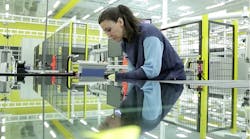Millennial Recruiting Magic: Solutions from Manufacturers Large and Small
Five years ago, Willington Nameplate, a Connecticut manufacturer of product labels and plates, did next to nothing to recommend itself to younger workers. The 50-year-old company’s workforce was on a slow march to retirement, with the average employee tenure at 17 years.
“Historically we would bring people in and put them in certain functions, and they would stay there until they screamed that they wanted out,” says Brett Greene, Willington’s president.
But as the family-owned company acquired three other players in the nameplate and labels sector, it realized it had to try harder. In came more big-name customers in automotive and aerospace, with more regulations and quality demands.
“In the past we joked that we were just looking for warm bodies—getting anyone to do manual tasks,” says Greene,. “But as our company has evolved … we can’t get that type of person just to come in and check their brain at the door and then go home.” They were on the hunt for “people who can adapt and think and learn multiple roles.”
To up the ante, Willington changed its interview process, redid its website, hired a branding firm that works with manufacturing clients and added a two-week training class for new employees. Now, with retirements and the infusion of fresh talent, the average workforce tenure is 12 to 13 years.
“We’ve transitioned quite a bit,” says Greene, himself a recruit, having joined the company in 2012 after working at Barnes Aerospace.
Any employer with half a clue has heard the refrain: Millennials want to work for companies where they can make a difference. Where they can be a valued part of the team, and have opportunities to learn, advance and be recognized.
The next step: taking it to heart. Manufacturers relying on word of mouth or just posting ads on job boards risk getting left behind, says John Heylinger, director of talent acquisition for Lockheed Martin.
“I think one of the things that a lot of companies probably don’t recognize is how soon millennials will make up the majority of their workforce, and if they’re not doing things to address that, it’s going to be harder to attract and keep them,” he warns.
The fact that unemployment is at its lowest rate in eight years only complicates the situation. To help employers who might need a nudge, manufacturers who’ve put some serious thought into attracting better candidates shared their recruiting problems with IndustryWeek, and how they fixed them.
Dilemma: We post a lot of job ads, but the response is underwhelming.
Solution: Put more thought into the content of your job postings.
Lockheed, says Heylinger, went through some soul-searching a few years back and decided it needed to play up its pizzazz factor. A senior communications person helped make over job titles and descriptions.
“We’ve built in opening paragraphs to speak a little bit differently than our very vanilla, boring job descriptions that we normally posted,” says Heylinger. “If you’re a software engineer and you’re working in avionics on the Orion [Mars mission], why not just call it ‘Avionic Software Engineer Working on Orion,’ or something that’s flashy? Because if you just put ‘Software Engineer’ along all the other software or mechanical engineer jobs on the market, chances are you’re just going to get sucked into looking like everybody else.”
While still fairly buttoned-up in tone, Lockheed ads now divulge more about roll-up-their-sleeve projects candidates would work on, and the stellar organizations involved (NASA, for one) and mention character traits like drive and the ability to collaborate. Occasionally, mirth even slips in. A posting for a Senior Staff Radar Systems Engineer in Orlando, Fla., declares: “If you love long freezing bone chilling cold snowy winters and shoveling snow, you will not enjoy your time in Orlando. “
Dilemma: Our website hardly gets any traffic, so we don’t use it for recruiting.
Solution: Potential candidates will spend time on your site if there’s something to look at. Create compelling content through employee stories, video showing off the technology, video.
SageGlass, a manufacturer of electrochromic glass in Minnesota, has a sleek website that cleverly uses text, video, photography and graphic design to tell its story. Click on “About SageGlass,” and a super-short video plays up the plant’s robotic finery and the dedicated young technicians who work there.
The website’s language is targeted to the YouTube generation, without overtly recruiting. It creates a narrative and conveys a sense of purpose: “Our company started in 1989 in Valley Cottage, N.Y., with a singular and ambitious mission: to completely reinvent what glass means for buildings.” It highlights a cross-section of team members’ photographs and bios, from the CEO to quality technicians, giving a sense that everyone contributes to the team.
Dilemma: Recruiters are a waste of money
Solution: A little handholding goes a long way.
Willington had worked with recruiters in the past, with dim results. “For a lot of the positions, we can find people who meet the skill sets but they just don’t fit the company culture,” says Greene. “And we have a pretty solid training curriculum, so we can train just about anyone, but you can’t train a culture fit.”
This time around, the company spent more time working with recruiters initially so they had a good handle on the company culture and the type of employee that would be a good fit.
“Instead of being transactional, the biggest thing is to just treat it as a partnership,” says Greene. “Bring them in and educate them as much as you can about the business. Be as clear as possible what your requirements are.”
Greene leads recruiters on plant tours so they can better understand the business. “They should be able to convey the story of your company almost as well as any employee,” he says. “We’re in constant communication with them. If they give us candidates we don’t feel are the right fit, we certainly give them feedback.” A good recruiting firm, he says, will take that feedback and make adjustments, “instead of just continually shoving the wrong type of candidate down our throat.”
Dilemma: We're just not finding people with the skills we need.
Solution: Develop training partnerships
Brent Robertson, a partner in Fathom, creative consultants that work with manufacturers on "future design," stresses that marketing alone does not a successful recruiting plan make. The other piece of it is having “regular relationships” with schools in the area that are producing desirable candidates. “The companies we work with who are wildly successful at this are either sponsoring events or they’re adjunct faculty, or they’re invited in to do lectures,” he says. “They bring student groups to their operations to give them a sense of what it looks like to be in manufacturing today.”
In Denver, which has a shortage of skilled workers in aerospace manufacturing, Lockheed worked with Metro State University on curriculum for an Advanced Engineering Sciences Program. The program trains students for aerospace jobs in industrial design, engineering tech and computer science. Students work on projects with Lockheed engineers and participate in co-ops and internships there.
ScotForge, the Illinois open die and rolled ring forging manufacturer, courts MBA student-teams from Northern Illinois University to work on solutions for problems at its plant. The students get to experience how a manufacturing facility works and learn about possible manufacturing career opportunities, and ScotForge not only gets a university-led cross-functional team to solve its problems but also the chance to recruit talented young people for internships and eventually, jobs.
Dilemma: We tried recruiting through social media and didn’t see any payoff.
Solution: Try Glassdoor.
One of SageGlass’ go-to recruiting tools is the company review site Glassdoor, says Amy Behne, SageGlass’s human resources manager. Behne likes the transparency of the site—that potential recruits can hear what it’s like from people who actually work at the company. And the reviews have been good: the company has a 4.5 out of five rating, and the CEO, 97% approval.
“There are several people who read about us on Glassdoor, who weren’t really looking, saw us and they work for us today,” Behne says. The company’s Glassdoor page links to videos that give a sense of the product and what the company culture is like, and also includes the same branding as its website and streams the SageGlass Facebook and Twitter accounts. At monthly performance meetings, employees hear about the importance of the site and are invited to post reviews about working at SageGlass.
Dell also makes Glassdoor a priority. “We post content there; we respond to reviews,” says Jennifer Newbill, senior management, talent brand. Dell has customized its Glassdoor page (employers can do that for a fee) and responded to 400 reviews there. “It’s a really important part of our overall recruiting strategy.”
Dilemma: Millennials just don’t want to work for us. We’re a small company that makes widgets.
Solution: Do a better job of telling your story.
Fathom’s Robertson says that organizations that are successful in millennial recruiting “talk about themselves—who they are and what they stand for—as well as what they make.
“And when I say, ‘mission and vision,’ I don’t mean the best product at the best price—all that B.S.,” he adds. “What if you brought this other story to bear: ‘We’re up to something bigger than just making this thing—we’re part of this company that comes together and celebrates.’”
That doesn’t mean being untruthful, but sharing more with the outside world about what working at the company is like—the teamwork, the day-to-day problem-solving, the company culture.
Willington, for instance, had been stuck on the fact that it makes “nuisance commodities,” including the serial number plates required on plumbing products and automobiles. Its new mission is more soul-stirring: “building for the future” and providing “some of the biggest companies in the aerospace, automotive and defense industries with the durable labeling solutions that put critical information where it’s needed for as long as it needs to last.”
Team members get starring roles in photos on the site and bios sharing their contributions to the company and their hobbies. “Some were like, ‘Oh my God, I don’t want to do that,’” says Greene, who told them, “Come on, you need to promote yourself a little.”
One of the newer employees, however, couldn’t wait to see his picture up on the website as soon as his six-month tryout period was up and he earned his bona fides. “That’s our conversion factor—once you’re a new employee you get your picture on the website,” says Greene.
When the young man’s portrait didn’t go up right away, he asked where it was because he wanted to show his mom, brother and sister. “We got him up there,” says Greene. “It just goes to show you, when we have the right type of individual and they are engaged, they look forward to that type of opportunity. And he’s a millennial employee, this particular one. So they get pretty vested, and that’s a good thing.”





